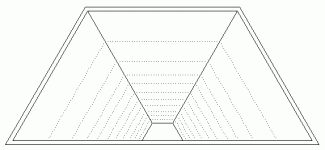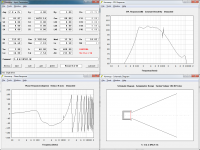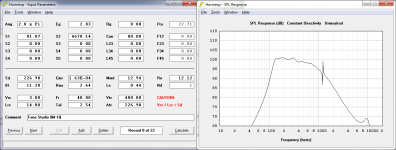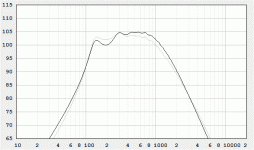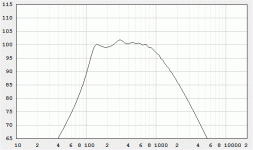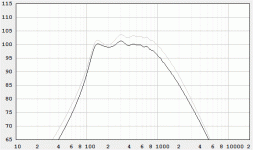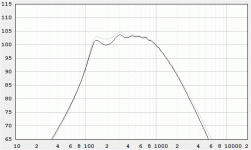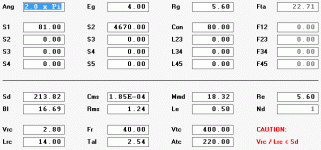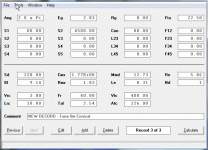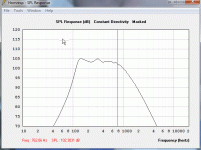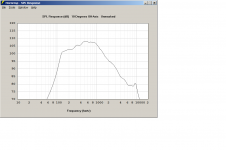Thinking of space constraints, half space loading and ease of construction...how's this for a crazy idea based on Experience Music.
A three petal horn with a flat base. Hornresp was fed with a double sized throat and mouth and exported for a 6 sided horn and only using three. (actually I needed to use a mccleach flare (0.8) because I couldn't fit a tractrix with double mouth and throat).
This image is not to scale.
A three petal horn with a flat base. Hornresp was fed with a double sized throat and mouth and exported for a 6 sided horn and only using three. (actually I needed to use a mccleach flare (0.8) because I couldn't fit a tractrix with double mouth and throat).
This image is not to scale.
Attachments
AllenB,
I found the conical midbass horn I made about 6 years ago. It was a nice performing horn with a solid 45 degree directivity angle. This uses the 8PE21-16. This is just to show you that you can make a conical midbass without the dip near Fc.
Rgs, JLH
I found the conical midbass horn I made about 6 years ago. It was a nice performing horn with a solid 45 degree directivity angle. This uses the 8PE21-16. This is just to show you that you can make a conical midbass without the dip near Fc.
Rgs, JLH
Attachments
Hi JLH
How does the conical sound compare to the Tractrix with the Fane? If you havnt heard the two as a comparison is there any chance of doing so?
The conical midbass could save a hell of a lot of work in the construction of midbass horns for all the new Fane 8m owners.
How does the conical sound compare to the Tractrix with the Fane? If you havnt heard the two as a comparison is there any chance of doing so?
The conical midbass could save a hell of a lot of work in the construction of midbass horns for all the new Fane 8m owners.
I wonder if it matters in midbass since the waves are so long and for a majority of the horn the contours are the same.
I wonder if it matters in midbass since the waves are so long and for a majority of the horn the contours are the same.
You're real close. The main difference is you can get a much wider sweet spot with the conical's directivity control. With the tractrix, the higher frequencies begin to beam and kind of lock you into a narrow listening position. The tractrix can give the woofer a little bit better loading, but with the stiff suspension of pro sound woofers and a well designed back chamber they are pretty close. You do need to push the resonance frequency up higher with the conical to get the same Fc. The conical does not have a set flare rate like the tractrix. The conical is an easier build and you can set your directivity angles to what ever you want. The tractrix has much better mouth diffraction behavior than a conical. It all depends on what you value the most. You can't go wrong with either one.
JLH,
The low end seems to take advantage of damping. Using your input screen in the first screenshot below, I then changed Eg to 2.83, Re to 5.6 and adjusted Rg to 1.5
I was then able to bring it back in the second shot by setting Rg to 8 ohms.
Qes is seen as an important factor in the choice of driver but if its preservation was so important then SETs would be seen as an issue. I could certainly afford the excess drive voltage to run them with series resistance.
The low end seems to take advantage of damping. Using your input screen in the first screenshot below, I then changed Eg to 2.83, Re to 5.6 and adjusted Rg to 1.5
I was then able to bring it back in the second shot by setting Rg to 8 ohms.
Qes is seen as an important factor in the choice of driver but if its preservation was so important then SETs would be seen as an issue. I could certainly afford the excess drive voltage to run them with series resistance.
Attachments
Second thoughts, I could always low pass filter...could be active. Setting Rg down demonstrates horn gain is greater than 6dB to below 300Hz. The horn is also shorter, smaller, and reaches lower than a tractrix
Shouldn't be too hard to whip up a five sided conical...then later I could add a mouth extension for treating diffraction.
Shouldn't be too hard to whip up a five sided conical...then later I could add a mouth extension for treating diffraction.
You can play with the source impedance of your amplifier using Rg. However, you cannot go changing Re because it is part of a fix set of T/S parameters. This is the T/S parameters of the 8PE21-16 I measured myself. Changing Re by itself messes up the whole simulation. Eg was set to 4 volts because this is a 16 ohm woofer.
Yes, but I was methodical....
I found that the other T/S parameters were relatively close to mine for the 8 ohm version and were much less significant. The most significant parameter to make a difference to the response by far was Re. I changed Eg to reflect the nominal equivalent of 1W into 8 ohms (but this obviously doesn't affect the shape of the curve).
The only real issue I can see, and am highlighting is the damping and its effect on the lower dip.
My only concern is that series resistance may defeat some of the benefit of such a large magnet and reduce the quality of the horn overall.
I found that the other T/S parameters were relatively close to mine for the 8 ohm version and were much less significant. The most significant parameter to make a difference to the response by far was Re. I changed Eg to reflect the nominal equivalent of 1W into 8 ohms (but this obviously doesn't affect the shape of the curve).
The only real issue I can see, and am highlighting is the damping and its effect on the lower dip.
My only concern is that series resistance may defeat some of the benefit of such a large magnet and reduce the quality of the horn overall.
It doesn't matter if the other parameters look similar. By changing Re you completely change the woofer's Bl product and how it is able to drive the horn. Without recalculating all the other parameters you can't really draw any conclusions from the simulation. The only screen input values you can change freely are Eg and Rg. Go and double click Bl and allow Hornresponse to recalculate BL - it will be much lower with a lower Re.
Fair call.
The first image here shows your sim verbatim, against factory specs for the 8 ohm version along with the adjusted Eg, all else the same.
The second shows the effect of running the 8 ohm driver with 3 ohm Zout verses an extra 5 ohms.
The first image here shows your sim verbatim, against factory specs for the 8 ohm version along with the adjusted Eg, all else the same.
The second shows the effect of running the 8 ohm driver with 3 ohm Zout verses an extra 5 ohms.
Attachments
I think an 11 or 13 sided conical could be a good start, will save a huge amount of work. Sims look good with nice low frequency extension. Thanks JLH for your help with this build.
I remember modeling a straight conical midbass horn and 2 and 3 step exponential ones when I built mine. There wasn't a huge difference in them. I built the straight conicals because I could make two templates for the sides and zip them all out on a router table pretty fast.
I didn't know the narrowing would be present in the midbass too.
I also thought that a tractrix wouldn't be as good of a choice as an exponential in the midbass because the tractrix didn't load until about 2x of the Fo of the horn. Not that a conical horn would load much better...
I didn't know the narrowing would be present in the midbass too.
I also thought that a tractrix wouldn't be as good of a choice as an exponential in the midbass because the tractrix didn't load until about 2x of the Fo of the horn. Not that a conical horn would load much better...
Size Matters
If flare does not matter then the horn is too short!
When signal wavelength is greater than horn length * 4, then it does not matter what kind of flare the passage has. As far as the LF signal is concerned it is not acoustically a horn that it is passing through.
Regards,
WHG
If flare does not matter then the horn is too short!
When signal wavelength is greater than horn length * 4, then it does not matter what kind of flare the passage has. As far as the LF signal is concerned it is not acoustically a horn that it is passing through.
Regards,
WHG
Mine were 1/4 sized I think...might be why I didn't see much difference in the different flares.
This is the T/S parameters of the 8PE21-16 I measured myself.
Just for interests sake here are the specs I measured for my 8PE21-8
Code:
fs = 82.5
Vas = 12.13 l
Qes = 0.21
Qms = 8.39
Qts = 0.205
Mms = 20.57 g
Zmax = 230 ohmsOther specs as shown on the input screen shot below.
I used the added mass technique for Vas which brought me within 10% of the published spec.
I copied Sd from you. I assumed you had studied the roll surround. I was watching it while I broke the drivers in and the inner pleat did move more than the outer ones.
I used the factory spec for Le.
Attachments
I am yet to start making dust on this build. I will try and sim the Fane 8m in a 100hz conical horn tonight. Since i wont be turning a big Le Cleach or tractrix i will be able to use an autotech JMLC 350 for the yamaha 6681 drivers.
I have ordered some american walnut veneer on 25mm mdf for the conical horns. Once templates are made the conical horns shoul be alot less work.
I have ordered some american walnut veneer on 25mm mdf for the conical horns. Once templates are made the conical horns shoul be alot less work.
A quick sim of the Fane 8m in a conical horn, looks good from 120hz to 600 or 700 hz.
Any opinions on wether the JMLC 350 or JMLC 400 would mate best to the Yamaha 6681? i am thining the 350, with its 600mm diameter, it will also visually suit the large mid bass horn. Yammy/JMLC 350 will do around 600 or 700 hz to 10khz, then a Fostex T500Amk2
Any opinions on wether the JMLC 350 or JMLC 400 would mate best to the Yamaha 6681? i am thining the 350, with its 600mm diameter, it will also visually suit the large mid bass horn. Yammy/JMLC 350 will do around 600 or 700 hz to 10khz, then a Fostex T500Amk2
Attachments
Last edited:
Hey 3GGG"
You can not sim a midbass/mid/high with constant directivity! Will not show response in front of the "funnel".
You should use "Tools/Directivity/Response/" and something like 10 degrees off-axis to get it realistic.
It will not get better with more petals, four is enough.
This is a sim using JLHs Fane-parameters.
You can not sim a midbass/mid/high with constant directivity! Will not show response in front of the "funnel".
You should use "Tools/Directivity/Response/" and something like 10 degrees off-axis to get it realistic.
It will not get better with more petals, four is enough.
This is a sim using JLHs Fane-parameters.
Attachments
Last edited:
- Status
- Not open for further replies.
- Home
- Loudspeakers
- Multi-Way
- Best 8" to 12" driver for 130hz tractrix horn
